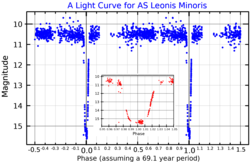 A light curve for AS Leonis Minoris. The main plot shows the full light curve, and the inset shows the time around minimum brightness at an expanded scale. Adapted from Lipunov et al. (2016) | |
| Observation data Epoch J2000 Equinox J2000 | |
|---|---|
| Constellation | Leo Minor |
| Right ascension | 09 53 10.001 |
| Declination | +33° 53′ 52.76″ |
| Apparent magnitude (V) | 10.7 - 15.4 |
| Characteristics | |
| Variable type | Algol |
| Astrometry | |
| Radial velocity (Rv) | -56.14 km/s |
| Proper motion (μ) | RA: 3.054±0.077 mas/yr Dec.: −11.645±0.071 mas/yr |
| Parallax (π) | 0.6994 ± 0.0513 mas |
| Distance | 4,700 ± 300 ly (1,400 ± 100 pc) |
| Other designations | |
| AS LMi, TYC 2505-672-1, MASTER OT J095310.04+335352.8, IRAS F09501+3408, 2MASS J09531000+3353527 | |
| Database references | |
| SIMBAD | data |
AS Leonis Minoris (AS LMi), also known as TYC 2505-672-1, is an eclipsing binary system in the constellation of Leo Minor. It has by far the longest period, 69.1 years, of any known eclipsing binary. During its roughly 3.45 year long eclipses, it fades by 4.5 magnitudes (about a factor of 60).
AS LMi's variability was first detected in 2013, during a search for "disappearing stars" in the MASTER database. It was initially thought to be an R Coronae Borealis variable star, although its fading was unusually slow for an R Coronae Borealis variable. Because R Coronae Borealis variables fade repeatedly, the discovery of the star's dramatic brightness decline triggered a search of archival photographic plates for evidence of earlier dimming events. Tang et al. used DASCH to search the large collection of Harvard photographic plates, and found that the star had dimmed for three years during the 1940s. They recognized that AS LMi is a very long period eclipsing binary, similar to the ε Aurigae system.
The binary system consists of an M-giant primary star orbited by a small hot secondary star that is itself surrounded by an optically thick (large optical depth) disk.
References
- ^ Lipunov, V.; Gorbovskoy, E.; Afanasiev, V.; Tatarnikova, A.; Denisenko, D.; Makarov, D.; Tiurina, N.; Krushinsky, V.; Vinokurov, A.; Balanutsa, P.; Kuznetsov, A.; Gress, O.; Sergienko, Yu.; Yurkov, V.; Gabovich, A.; Tlatov, A.; Senik, V.; Vladimirov, V.; Popova, E. (April 2016). "Discovery of an unusual bright eclipsing binary with the longest known period: TYC 2505-672-1/MASTEROTJ095310.04+335352.8". Astronomy & Astrophysics. 588: A90. arXiv:1602.06010. Bibcode:2016A&A...588A..90L. doi:10.1051/0004-6361/201526528. S2CID 119116308.
- ^ Brown, A. G. A.; et al. (Gaia collaboration) (August 2018). "Gaia Data Release 2: Summary of the contents and survey properties". Astronomy & Astrophysics. 616. A1. arXiv:1804.09365. Bibcode:2018A&A...616A...1G. doi:10.1051/0004-6361/201833051. Gaia DR2 record for this source at VizieR.
- ^ "AS LMi". The International Variable Star Index. AAVSO. Retrieved 7 December 2021.
- ^ Rodriguez, Joseph E.; Stassun, Keivan G.; Lund, Michael B.; Siverd, Robert J.; Pepper, Joshua; Tang, Sumin; Kafka, Stella; Gaudi, B. Scott; Conroy, Kyle E.; Beatty, Thomas G.; Stevens, Daniel J.; Shappee, Benjamin J.; Kochanek, Christopher S. (May 2016). "An Extreme Analogue of ɛ Aurigae: An M-giant Eclipsed Every 69 Years by a Large Opaque Disk Surrounding a Small Hot Source". The Astronomical Journal. 151 (5): 123. arXiv:1601.00135. Bibcode:2016AJ....151..123R. doi:10.3847/0004-6256/151/5/123. S2CID 24349954.
- Denisenko, D.; et al. (4 February 2013). "Optical "anti-transient" detected by MASTER". The Astronomer's Telegram. 4784: 1. Bibcode:2013ATel.4784....1D.
- Nesci, R. (February 2013). "Tyc 2505-672-1". The Astronomer's Telegram. 4787: 1. Bibcode:2013ATel.4787....1N.
- Drake, A. J.; Djorgovski, S. G.; Mahabal, A. A.; Graham, M. J.; Williams, R.; Prieto, J.; Catelan, M.; Christensen, E.; Larson, S. M. (February 2013). "Catalina observations of TYC 2505-672-1 (MASTER OTJ095310.04+335352.8". The Astronomer's Telegram. 4788: 1. Bibcode:2013ATel.4788....1D.
- Tang, Sumin; Grindlay, J. E.; Bildsten, L. (July 2013). "A Mysterious Twin of Epsilon-Aurigae". Bulletin of the American Astronomical Society. 45: 20302. Bibcode:2013giec.conf20302T.
| Constellation of Leo Minor | |||||||||||||
|---|---|---|---|---|---|---|---|---|---|---|---|---|---|
| Stars |
| ||||||||||||
| |||||||||||||
| Galaxies |
| ||||||||||||